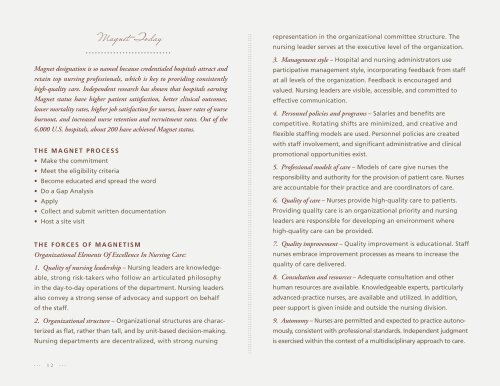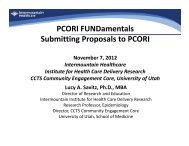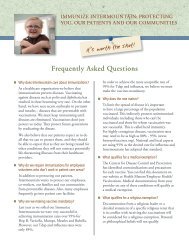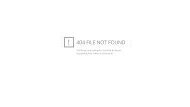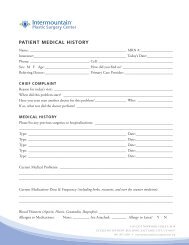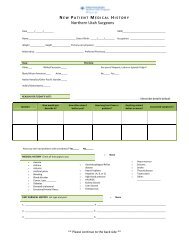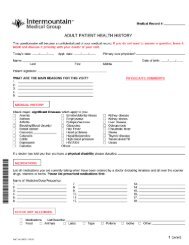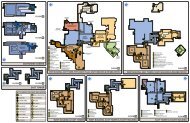Annual Nursing Update - Intermountain Healthcare
Annual Nursing Update - Intermountain Healthcare
Annual Nursing Update - Intermountain Healthcare
- No tags were found...
You also want an ePaper? Increase the reach of your titles
YUMPU automatically turns print PDFs into web optimized ePapers that Google loves.
Magnet TodayMagnet designation is so named because credentialed hospitals attract andretain top nursing professionals, which is key to providing consistentlyhigh-quality care. Independent research has shown that hospitals earningMagnet status have higher patient satisfaction, better clinical outcomes,lower mortality rates, higher job satisfaction for nurses, lower rates of nurseburnout, and increased nurse retention and recruitment rates. Out of the6,000 U.S. hospitals, about 200 have achieved Magnet status.T h e M a g n e t P r o c e s s• Make the commitment• Meet the eligibility criteria• Become educated and spread the word• Do a Gap Analysis• Apply• Collect and submit written documentation• Host a site visitT h e F o r c e s o f M a g n e t i s mOrganizational Elements Of Excellence In <strong>Nursing</strong> Care:1. Quality of nursing leadership – <strong>Nursing</strong> leaders are knowledgeable,strong risk-takers who follow an articulated philosophyin the day-to-day operations of the department. <strong>Nursing</strong> leadersalso convey a strong sense of advocacy and support on behalfof the staff.2. Organizational structure – Organizational structures are characterizedas flat, rather than tall, and by unit-based decision-making.<strong>Nursing</strong> departments are decentralized, with strong nursingrepresentation in the organizational committee structure. Thenursing leader serves at the executive level of the organization.3. Management style – Hospital and nursing administrators useparticipative management style, incorporating feedback from staffat all levels of the organization. Feedback is encouraged andvalued. <strong>Nursing</strong> leaders are visible, accessible, and committed toeffective communication.4. Personnel policies and programs – Salaries and benefits arecompetitive. Rotating shifts are minimized, and creative andflexible staffing models are used. Personnel policies are createdwith staff involvement, and significant administrative and clinicalpromotional opportunities exist.5. Professional models of care – Models of care give nurses theresponsibility and authority for the provision of patient care. Nursesare accountable for their practice and are coordinators of care.6. Quality of care – Nurses provide high-quality care to patients.Providing quality care is an organizational priority and nursingleaders are responsible for developing an environment wherehigh-quality care can be provided.7. Quality improvement – Quality improvement is educational. Staffnurses embrace improvement processes as means to increase thequality of care delivered.8. Consultation and resources – Adequate consultation and otherhuman resources are available. Knowledgeable experts, particularlyadvanced-practice nurses, are available and utilized. In addition,peer support is given inside and outside the nursing division.9. Autonomy – Nurses are permitted and expected to practice autonomously,consistent with professional standards. Independent judgmentis exercised within the context of a multidisciplinary approach to care.. . . 1 2 . . .


